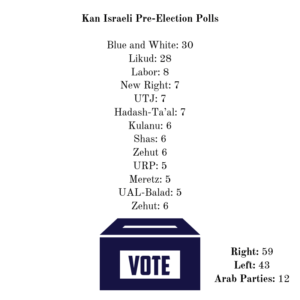The headlines are already written, and the digital ink is dry on the results for Israel’s 2019 national elections on April 9. Some version of “Netanyahu re-elected despite corruption charges,” will be plastered across Israel and even around the world.
Before jumping to opinions or analysis about what that result would mean, first we have to understand how it’ll (probably) happen. A disclaimer: yes, this is my prediction, and if you don’t believe me or the math, feel free to check out what papers like Times of Israel or The Jerusalem Post are reporting. The prediction is unrelated to my personal feelings toward Netanyahu.
If you’ve checked out the TC Jewfolk guide to Israeli elections, you’ll know that elections are only part of the battle for who becomes prime minister and forms the next Israeli government. With 120 available seats in the Knesset (Israel’s parliament) a group of parties has to come together to form a 61 seat or more majority coalition to create a functioning government.
In America, the political game is seemingly simple. Politicians do the math on whether or not they get a majority of the vote, either through the electoral college or the common folk. If you get a majority, you’re in, and if not, so long sucker.
In Israel, once the first level of politicking is done by popular vote for Knesset parties, the second, internal level begins. What parties can find enough common interest to join together in a coalition? What compromises will have to be made? And what does the average of, say, 7 party platforms turn out to be?
The main center of gravity is whether you’re on the left or on the right, a Zionist party or non-Zionist party, and willing to humor the ultra-Orthodox or not. The nuances of each are distinctly Israeli.
Take the Likud and Blue and White parties. Both are polling around 30 seats, which makes them the largest parties in the next Knesset and available to form the governing coalition (the Israeli president picks which party gets to try first). Likud is the party of current Prime Minister Benjamin Netanyahu, and comfortably center-right. Blue and White is headed by three former Israeli chiefs of staff/generals, ranging from center to right-wing, and one prominent center/center-right politician.
Because Likud is the classic right-wing, Blue and White becomes “left”. This makes the coalition politics easier to understand, notwithstanding the basically false labeling of Blue and White.
Now the distinction of Zionist and non-Zionist parties. Before we go further: the essence of Zionism is the belief in Jewish self-governance in a Jewish state in the land of Eretz Israel. Like all ideologies, there are many spots and stripes, but that’s a conversation for another time. Israeli political non-Zionism essentially says Israel should not be a particularistic Jewish state, but just a state that happens to have a lot of Jews and a good amount of non-Jews.
Every Israeli political party is officially Zionist, with the definite exception of the four Israeli-Arab/Palestinian parties on the far left, and, to some extent, the far-left Meretz party, which officially removed Zionism from its platform a few years ago.
 This significantly reduces the number of coalition partners on the left that Blue and White can have. The Labour party is left and Zionist, Meretz is left and questionably Zionist, and the Israeli-Arab/Palestinian parties exist, but it’s political suicide to make a coalition with them. Labour and Meretz, according to a recent poll by the Israeli broadcasting company Kan, get 13 Knesset seats.
This significantly reduces the number of coalition partners on the left that Blue and White can have. The Labour party is left and Zionist, Meretz is left and questionably Zionist, and the Israeli-Arab/Palestinian parties exist, but it’s political suicide to make a coalition with them. Labour and Meretz, according to a recent poll by the Israeli broadcasting company Kan, get 13 Knesset seats.
With Blue and White’s 30 seats, that’s a 43 seat coalition, too far from the 61 seat majority required to make the government. If, by a long shot, the Arab parties are included, adding another 12 seats, that brings the coalition up to 55 seats. But no other party will agree to be in a coalition with the Arab parties (or even Meretz), so there’s little chance of things going further.
And that is why Blue and White, the best shot at taking down Netanyahu, will fail to do so with current polling numbers, which fluctuate poll to poll but overall stay the same.
The rest of the political spectrum, made up of Likud and the parties to the right of Likud, would form a coalition of around 65 seats – barely a coalition, but a majority governing coalition nonetheless. Thus, Netanyahu’s reelection in two weeks. Feel free to do the math with the Kan poll numbers.
For anyone willing to entertain a huge theoretical for the sake of learning another factor of current Israeli politics: Let’s say that Blue and White wins 33 ish Knesset seats, and starts to attract interested right-wing parties. While all bets are off at this stage, you might ask why the ultra-Orthodox parties, with around 13 seats, can’t join the Blue and White coalition and ruin any chance of a Netanyahu/Likud led government.
A development like that would change the game, but it can’t happen. One of the heads of Blue and White, Yair Lapid, is avowedly against Israeli government bankrolling of the ultra-Orthodox in Israel, many of whom avoid the mandatory army draft and are not a part of the Israeli workforce. The ultra-Orthodox parties would never tolerate a coalition with Lapid (nor he with them), so their only way in is with Netanyahu.
Either way you cut it, the stronger loyalties are with the right-wing and Netanyahu. Best to understand that now, and save yourself the surprises.

